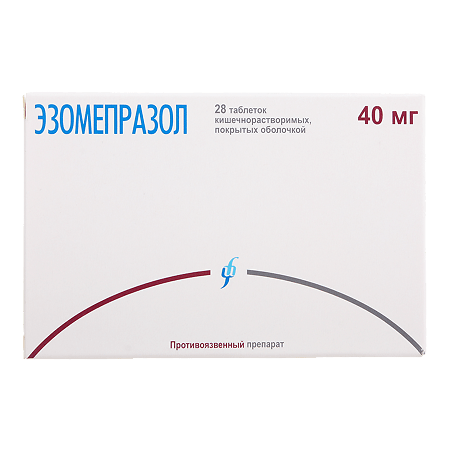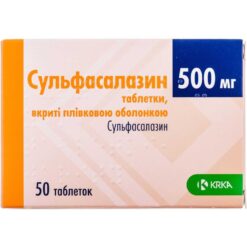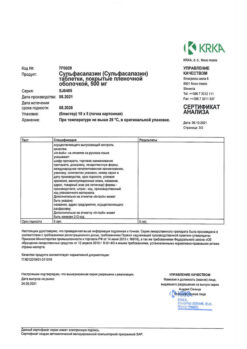No products in the cart.
Esomeprazole, 40 mg 28 pcs
€12.37 €10.31
Out of stock
(E-mail when Stock is available)
EAN: 4660007705634
SKU: 494081
Categories: Medicine, Stomach, intestines, liver, Ulcer and gastritis
Description
Inhibiting the proton pump.
Pharmacokinetics
Absorption and distribution.
Esomeprazole is unstable in acidic environments; therefore, for oral administration enteric coated tablets are used. Under in vivo conditions only a small part of esomeprazole is converted to the R-isomer.
Eating slows and reduces absorption of esomeprazole in the stomach, but this has no significant effect on the effectiveness of inhibiting hydrochloric acid secretion.
The drug is rapidly absorbed: the maximum plasma concentration (Cmax) is reached 1-2 hours after administration. Absolute bioavailability of esomeprazole after a single dose of 40 mg is 64% and increases to 89% after daily dosing.
For the 20 mg dose of esomeprazole these values are 50% and 68%, respectively. The volume of distribution at equilibrium concentration in healthy subjects is approximately 0.22 l/kg body weight. Esomeprazole is 97% bound to plasma proteins.
Metabolism and excretion.
Esomeprazole is metabolized with cytochrome P450 isoenzymes. The main part is metabolized with participation of a specific polymorphic isoenzyme CYP2C19, with the formation of hydroxylated and demethylated metabolites of esomeprazole.
The metabolism of the remaining part is carried out by the CYP3A4 isoenzyme, which produces sulfo-derivative of esomeprazole, which is the main metabolite detected in plasma.
The parameters below mainly reflect the pharmacokinetics in patients with increased CYP2C19 isoenzyme activity.
The total clearance is approximately 17 l/h after a single dose of the drug and 9 l/h after multiple doses. The elimination half-life (T1/2) is 1.3 hours with systemic administration once daily. AUC increases with repeated administration of esomeprazole.
The dose-dependent increase in AUC with repeated administration of esomeprazole is nonlinear, which is a consequence of a decrease in metabolism during “first passage” through the liver and a decrease in systemic clearance, probably caused by inhibition of the CYP2C19 isoenzyme by esomeprazole and/or its sulfo derivatives.
Esomeprazole is completely eliminated from the blood plasma between doses and does not cumulate when taken once daily.
The main metabolites of esomeprazole do not affect the secretion of hydrochloric acid in the stomach. When administered orally, up to 80% of the dose is excreted as metabolites by the kidneys, another part is excreted by the intestine. In urine less than 1% of unchanged esomeprazole is detected.
Peculiarities of pharmacokinetics in some groups of patients About 2.9 ± 1.5% of patients have reduced activity of CYP2C19 isoenzyme. In these patients the metabolism of esomeprazole is mainly carried out by the CYP3A4 isoenzyme.
In systemic administration of 40 mg of esomeprazole once daily, the average AUC is 100% higher than this parameter in patients with increased CYP2C19 isoenzyme activity. Mean values of maximum plasma concentrations in patients with decreased isoenzyme activity are increased by approximately 60%.
The above features do not affect the dose and route of administration of esomeprazole. In elderly patients (71-80 years) the metabolism of esomeprazole is not significantly altered.
After a single dose of 40 mg of esomeprazole, the average AUC in women is 30% higher than in men. There are no differences in pharmacokinetics in men and women when taking the drug once daily. These characteristics do not affect the dose and route of administration of esomeprazole.
The metabolism of esomeprazole may be impaired in patients with mild to moderate hepatic impairment. In patients with severe hepatic impairment the metabolic rate is reduced, resulting in a 2-fold increase in the AUC value for esomeprazole.
There have been no studies of pharmacokinetics in patients with renal impairment.
Since it is not the esomeprazole itself but its metabolite that is excreted through the kidneys, it can be assumed that the metabolism of esomeprazole in patients with renal impairment is not altered.
In children aged 12-18 years, after repeated administration of 20 mg and 40 mg of esomeprazole, the AUC and time to peak plasma concentration (TCmax) were similar to the AUC and TCmax in adults.
Pharmacodynamics
Esomeprazole is the S-isomer of omeprazole and reduces gastric hydrochloric acid secretion by specifically inhibiting the proton pump in the parietal cells of the stomach. S- and R-isomers of omeprazole have similar pharmacodynamic activity. Mechanism of action.
Esomeprazole is a weak base that changes to its active form in the highly acidic environment of the secretory tubules of the parietal cells of the gastric mucosa and inhibits the proton pump enzyme H+/K+- ATPase, with inhibition of both basal and stimulated hydrochloric acid secretion.
The effect on the secretion of hydrochloric acid in the stomach.
After oral administration of 20 mg or 40 mg, the effects of esomeprazole develop within 1 hour. When administered daily for 5 days in a dose of 20 mg once daily, the average maximum concentration of hydrochloric acid after pentagastrin stimulation decreased by 90% (when measuring acid concentration 6-7 hours after taking the drug on the 5th day of therapy).
In patients with gastroesophageal reflux disease (GERD) and the presence of clinical symptoms after 5 days of daily oral administration of esomeprazole at a dose of 20 mg or 40 mg, intragastric pH values above 4.0 were maintained for an average of 13 and 17 hours of 24 hours.
After administration of esomeprazole at a dose of 20 mg per day, intragastric pH values above 4.0 were maintained for at least 8, 12, and 16 hours in 76%, 54%, and 24% of patients, respectively.
The correlation between the drug concentration in plasma and inhibition of hydrochloric acid secretion was detected (to estimate the concentration we used the parameter AUC – area under the curve “concentration – time”. The therapeutic effect achieved as a result of inhibition of hydrochloric acid secretion.
When taking the drug at a dose of 40 mg, healing of reflux esophagitis occurred in approximately 78% of patients after 4 weeks of therapy and in 93% of patients after 8 weeks of therapy.
Treatment with esomeprazole at a dose of 20 mg twice daily in combination with appropriate antibiotics for one week results in successful eradication of Helicobacter pylori in approximately 90% of patients.
Patients with uncomplicated peptic ulcer disease after one week of eradication do not require subsequent monotherapy with drugs that reduce gastric gland secretion for ulcer treatment and relief of symptoms. Esomeprazole has been shown to be effective in peptic ulcer bleeding confirmed endoscopically.
Other effects related to inhibition of hydrochloric acid secretion During treatment with drugs that decrease gastric gland secretion, plasma gastrin concentrations are increased as a result of decreased hydrochloric acid secretion.
The decrease in hydrochloric acid secretion increases chromogranin A (CgA) concentrations. Increased concentration of CgA may affect the results of examinations to detect neuroendocrine tumors. To prevent this effect, esomeprazole should be temporarily discontinued 5 days prior to the CgA study.
In patients receiving esomeprazole for a long time, an increase in enterochromaffin-like cells has been observed, probably related to an increase in plasma gastrin concentration.
Patients taking drugs that reduce gastric gland secretion over a long period of time are more likely to have glandular cysts in the stomach. These phenomena are due to physiological changes resulting from marked inhibition of hydrochloric acid secretion. The cysts are benign and undergo reverse development.
The use of drugs that inhibit the secretion of hydrochloric acid in the stomach, including proton pump inhibitors, is accompanied by an increase in gastric microbial flora normally present in the gastrointestinal tract.
The use of proton pump inhibitors may result in a small increase in the risk of gastrointestinal tract infections caused by Salmonella spp. and Campylibacter spp. bacteria and probably Clostridium difficile in hospitalized patients.
In two comparative studies with ranitidine, esomeprazole showed better efficacy for the treatment of gastric ulcers in patients treated with nonsteroidal anti-inflammatory drugs (NSAIDs), including selective cyclooxygenase-2 inhibitors (COX-2).
Clinical pharmacology
H+-K+-ATPase inhibitor.
Indications
Indications
Active ingredient
Active ingredient
Composition
Composition
How to take, the dosage
How to take, the dosage
An additional 4-week course of treatment is recommended in cases when after the first course healing of esophagitis does not occur or, symptoms persist.
Long-term maintenance treatment after healing of erosive reflux esophagitis, prevention of recurrence: 20 mg once daily.
Symptomatic treatment of GERD: 20 mg once daily in patients without esophagitis. If after 4 weeks of treatment symptoms do not disappear, further examination of the patient should be carried out. After elimination of symptoms, it is possible to switch to the drug regimen “as needed” – 20 mg 1 time/day if symptoms recur. For patients taking NSAIDs and those at risk of developing gastric or duodenal ulcer, treatment with the “as needed” regimen is not recommended.
As part of combination therapy for eradication of Helicobacter pylori:
Treatment of duodenal ulcer associated with Helicobacter pylori: Esomeprazole Canon 20 mg, amoxicillin 1000 mg and clarithromycin 500 mg. All drugs are taken 2 times daily for 1 week.
Prevention of recurrence of peptic ulcer associated with Helicobacter pylori: Esomeprazole Canon 20 mg, amoxicillin 1000 mg and clarithromycin 500 mg. All drugs are taken 2 times daily for 1 week.
Long-term acid suppressive therapy in patients who have had bleeding from a peptic ulcer (after IV administration of drugs that reduce gastric gland secretion, to prevent recurrence): Esomeprazole Canon 40 mg once daily for 4 weeks after IV administration of gastric gland-reducing drugs.
Treatment of gastric ulcers caused by taking NSAIDs: Esomeprazole Canon 20 mg once daily; treatment duration 4-8 weeks.
Prevention of gastric and duodenal ulcers caused by taking NSAIDs: Esomeprazole Canon 20 mg once daily.
Conditions characterized by pathological hypersecretion of gastric glands, including Zollinger-Ellison syndrome and idiopathic hypersecretion: Recommended starting dose of Esomeprazole Canon 40 mg 2 times daily.
The dose is then adjusted individually; the duration of treatment is determined by the clinical picture of the disease. There is experience of using from 80 to 160 mg of esomeprazole per day; when taking the drug more than 80 mg/day, it is recommended to divide the required dose into 2 doses.
Hepatic failure: No dose adjustment is required in mild to moderate hepatic failure. For patients with severe hepatic insufficiency, the maximum daily dose should not exceed 20 mg.
Special Instructions
Special Instructions
In the presence of any alarming symptoms (such as significant spontaneous weight loss, recurrent vomiting, dysphagia, bloody vomiting, or melena) and the presence of a peptic ulcer (or suspected peptic ulcer), malignancy should be excluded, as treatment with esomeprazole may alleviate the symptoms and delay diagnosis.
Patients who take the drug for a long period of time (especially more than a year) should have their physician monitor them regularly.
Dizziness, blurred vision, and drowsiness may occur during treatment, so caution should be exercised when driving motor vehicles and engaging in other potentially hazardous activities that require increased concentration and quick psychomotor reactions.
Contraindications
Contraindications
Side effects
Side effects
Nervous system disorders: frequently – headache; infrequently – drowsiness, insomnia, dizziness, paresthesia; rarely – agitation, confusion, depression; very rarely – aggressive behavior, hallucinations.
Respiratory system disorders: rarely – bronchospasm.
Digestive system disorders: frequent – abdominal pain, diarrhea, flatulence, nausea, vomiting, constipation; infrequent – dry mouth, increased activity of “liver” enzymes; rare – stomatitis, GI candidiasis, hepatitis (with or without jaundice); very rare – liver failure, liver encephalopathy in patients with a history of liver disease, microscopic colitis.
Renal and urinary tract disorders: very rare – interstitial nephritis; frequency unknown – renal failure.
Reproductive system disorders: very rare – gynecomastia.
Motor system disorders: rare – arthralgia, myalgia; very rare – muscle weakness; frequency unknown – fractures of the femoral neck, carpal bones, vertebrae.
Skin disorders: infrequent – itching, rash, urticaria, dermatitis, peripheral edema; rare – alopecia, photosensitization, malaise, increased sweating; very rare – Stevens-Johnson syndrome, toxic epidermal necrolysis, erythema multiforme.
Hematopoietic disorders: rarely – leukopenia, thrombocytopenia; very rarely – agranulocytosis, pancytopenia.
Sense organ disorders: infrequent – blurred vision, rarely – taste disorders.
Allergic reactions: rare – hypersensitivity reactions (e.g., fever, angioedema, anaphylactic reaction/anaphylactic shock).
Similarities
Similarities
Additional information
| Weight | 0.033 kg |
|---|---|
| Manufacturer | Izvarino Pharma, Russia |
| Medication form | enteric soluble tablets |
| Brand | Izvarino Pharma |
Related products
Buy Esomeprazole, 40 mg 28 pcs with delivery to USA, UK, Europe and over 120 other countries.










